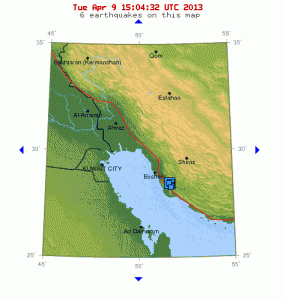April 9, 2013. Within 90 minutes, six large earthquakes struck Iran along the coast of the Persian Gulf next to Iran’s only nuclear power plant. The largest quake registered a 6.3 magnitude, followed by a 5.4 quake, two 4.7 earthquakes, a 4.2, and a 4.8 quake.
Don’t Let the Aftershocks Fool You
Aftershock quakes are dangerous because they are as unpredictable as the initial earthquake. Bigger earthquakes typically have more and larger aftershocks, but don’t let the word aftershock fool you. Aftershocks are still earthquakes even though the word leads us to assume that they are simply less damaging vibrations or the finish-out from a larger earthquake. The Earth’s crust adjusts to the effects of any shock quake, and any Earth shifting, whether an aftershock a foreshock or a main break, is an earthquake that needs to be taken seriously.
We seem to think that the aftershocks are not as dangerous as the main quakes, but this is not always the case. With the recent increase in earthquake magnitudes, aftershocks are better described as “an earthquake cluster or swarm.” Aftershock quakes can be of a large magnitude, which can collapse buildings that are damaged by the main quake, snap bridges, damage nuclear power plants, and demolish houses and other buildings.
Today with the drastic uptick in global earthquakes, it is more accurate, and much more helpful to the surrounding populations, to take the after quakes much more seriously.
The day is not over yet. so be on the look-out for more earthquakes to rattle Iran.


